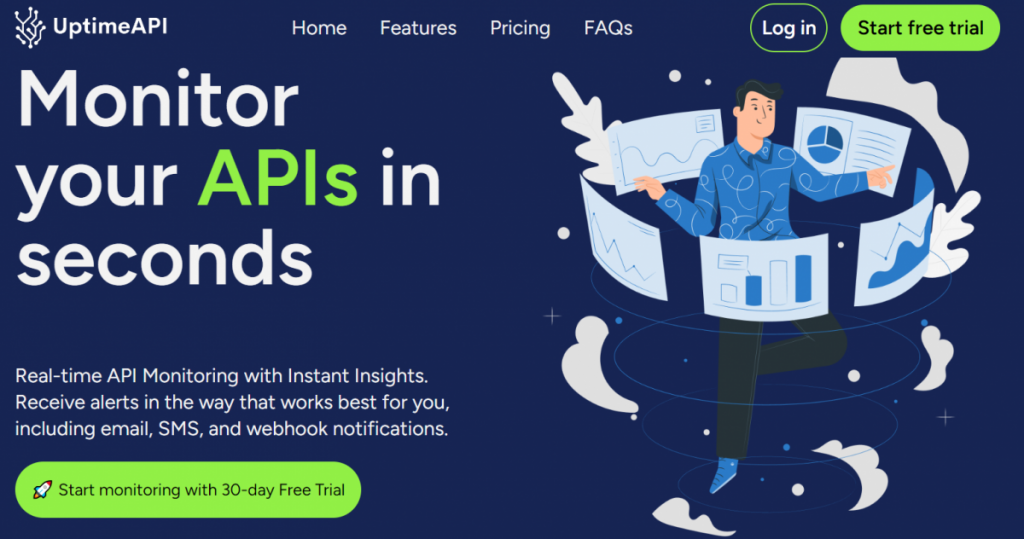In the realm of website and server monitoring, UptimeRobot has been a popular choice for many developers and businesses. However, the diverse needs of users often lead them to explore alternatives to find the best fit for their requirements. This article aims to shed light on UptimeRobot alternative, focusing on one standout option: UptimeAPI. We will delve into the criteria for evaluating alternatives and explore the key components of UptimeAPI’s API response.
Criteria for Evaluating UptimeRobot Alternatives

Before we delve into specific alternatives, it’s crucial to establish the criteria for evaluating monitoring tools. Here are some key factors to consider:
1. Monitoring Capabilities
Look for alternatives that offer robust monitoring capabilities, allowing you to track the uptime, response times, and overall performance of your websites and servers.
2. Alerting Mechanisms
Effective alerting is essential for timely responses to downtime or performance issues. Consider alternatives that provide customizable alerting mechanisms through various channels such as email, SMS, or integrations with communication tools.
3. Scalability
As your infrastructure grows, scalability becomes crucial. Opt for alternatives that can seamlessly scale to accommodate the increasing demands of monitoring multiple endpoints.
4. User-Friendly Interface
A user-friendly interface ensures ease of use and quick access to essential information. Choose alternatives that offer an intuitive dashboard and straightforward setup processes.
5. Affordability
Evaluate the cost-effectiveness of alternatives, considering factors such as pricing plans, features offered, and any hidden costs.
UptimeAPI as a Robust UptimeRobot Alternative

Read More: Company profile APIUsage Cases
1. Real-Time Monitoring
UptimeAPI stands out as a robust alternative with real-time monitoring capabilities. It provides instant visibility into the health and performance of your websites and APIs, allowing you to detect and address issues promptly.
2. Customizable Alerting
Similar to UptimeRobot, UptimeAPI offers customizable alerting mechanisms. Tailor alerts based on specific parameters such as response time, error rate, or downtime duration. This flexibility ensures that you receive notifications relevant to your application’s needs.
3. Scalable Solutions
UptimeAPI caters to the modern demands of scalable infrastructure. Whether you have a single website or a complex system with multiple endpoints, UptimeAPI can scale to accommodate your monitoring needs.
4. User-Friendly Interface
The user interface of UptimeAPI is designed with simplicity in mind. The dashboard provides a clear overview of your monitored endpoints, making it easy for developers and administrators to navigate and access crucial information.
5. Affordable Plans
UptimeAPI offers affordable plans, making it a cost-effective alternative to UptimeRobot. The variety of plans allows users to choose an option that aligns with their budget and monitoring requirements.
Exploring Other UptimeRobot Alternatives
While UptimeAPI stands out as a compelling alternative, it’s essential to consider other options based on your specific needs. Here are a few notable alternatives:
1. Pingdom
Pingdom is a popular choice known for its comprehensive monitoring features. It provides real-time alerts, performance insights, and a user-friendly interface. However, the pricing may be higher compared to other alternatives.
2. StatusCake
StatusCake offers a range of monitoring solutions, including website, server, and SSL monitoring. It provides a free plan with basic features and affordable paid plans for more advanced monitoring needs.
3. Site24x7
Site24x7 is a comprehensive monitoring platform that covers websites, servers, applications, and networks. It offers a wide range of features, including synthetic monitoring and AI-driven insights. However, it may be more suitable for larger enterprises with complex monitoring requirements.
Understanding the UptimeAPI API Response
When monitoring an API endpoint with UptimeAPI, the API response provides crucial information about the status and performance. Let’s break down a typical API response:
{
“status”: “success”,
“timestamp”: “2024-01-17T12:00:00Z”,
“endpoint”: “https://api.example.com”,
“response_time”: 50,
“error_rate”: 0.1
}
Key Components of the API Response:
- status: Indicates whether the API request to UptimeAPI was successful. “Success” means the request was processed without errors.
- timestamp: Provides the date and time of the API response.
- endpoint: Specifies the monitored API endpoint.
- response_time: Represents the time taken for the API endpoint to respond (in milliseconds).
- error_rate: Indicates the percentage of requests that resulted in errors.
Understanding these components allows you to interpret the health and performance of your API endpoint through the UptimeAPI response.

